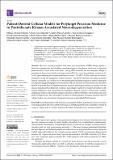Por favor, use este identificador para citar o enlazar a este item:
http://hdl.handle.net/10261/341877COMPARTIR / EXPORTAR:
 SHARE
BASE SHARE
BASE
|
|
| Visualizar otros formatos: MARC | Dublin Core | RDF | ORE | MODS | METS | DIDL | DATACITE | |

| Título: | Patient-Derived Cellular Models for Polytarget Precision Medicine in Pantothenate Kinase-Associated Neurodegeneration |
Autor: | Álvarez-Córdoba, Mónica; Talaverón-Rey, Marta; Povea-Cabello, Suleva; Cilleros-Holgado, Paula; Gómez-Fernández, David; Piñero-Perez, Rocío; Reche-López, Diana; Munuera, Manuel CSIC; Suárez-Carrillo, Alejandra; Romero-González, Ana; Romero-Domínguez, José Manuel; López-Cabrera, Alejandra; Armengol, José Ángel; Sánchez-Alcázar, José Antonio CSIC ORCID | Palabras clave: | Neurodegeneration with brain iron accumulation (NBIA) Pantothenate kinase-associated neurodegeneration (PKAN) Pantothenate kinase 2 (PANK2) Pantothenate Pantethine Vitamin E Omega 3 α-lipoic acid L-carnitine Thiamine Fibroblasts Induced neurons Precision medicine |
Fecha de publicación: | 2023 | Editor: | Multidisciplinary Digital Publishing Institute | Citación: | Pharmaceuticals 16(10): 1359 (2023) | Resumen: | The term neurodegeneration with brain iron accumulation (NBIA) brings together a broad set of progressive and disabling neurological genetic disorders in which iron is deposited preferentially in certain areas of the brain. Among NBIA disorders, the most frequent subtype is pantothenate kinase-associated neurodegeneration (PKAN) caused by pathologic variants in the PANK2 gene codifying the enzyme pantothenate kinase 2 (PANK2). To date, there are no effective treatments to stop the progression of these diseases. This review discusses the utility of patient-derived cell models as a valuable tool for the identification of pharmacological or natural compounds for implementing polytarget precision medicine in PKAN. Recently, several studies have described that PKAN patient-derived fibroblasts present the main pathological features associated with the disease including intracellular iron overload. Interestingly, treatment of mutant cell cultures with various supplements such as pantothenate, pantethine, vitamin E, omega 3, α-lipoic acid L-carnitine or thiamine, improved all pathophysiological alterations in PKAN fibroblasts with residual expression of the PANK2 enzyme. The information provided by pharmacological screenings in patient-derived cellular models can help optimize therapeutic strategies in individual PKAN patients. | Versión del editor: | http://dx.doi.org/10.3390/ph16101359 | URI: | http://hdl.handle.net/10261/341877 | DOI: | 10.3390/ph16101359 | Identificadores: | e-issn: 1424-8247 |
| Aparece en las colecciones: | (CABD) Artículos |
Ficheros en este ítem:
| Fichero | Descripción | Tamaño | Formato | |
|---|---|---|---|---|
| Patient-Derived Cellular_Álvarez_PV_Art2023.pdf | 1,82 MB | Adobe PDF |  Visualizar/Abrir |
CORE Recommender
Page view(s)
12
checked on 28-abr-2024
Download(s)
17
checked on 28-abr-2024
Google ScholarTM
Check
Altmetric
Altmetric
Este item está licenciado bajo una Licencia Creative Commons

